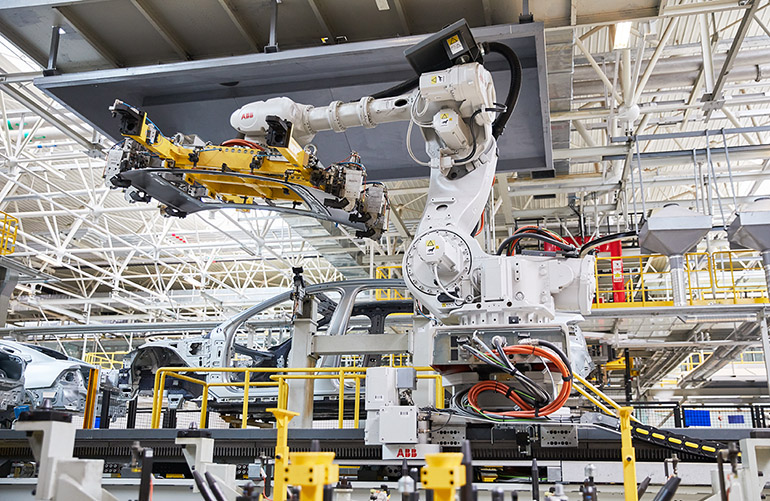|
Listen to this article  |

Automotive manufacturing will continue to drive North American robotics adoption, says A3. Source: ABB
The Association for Advancing Automation, or A3, today released its quarterly and end-of-year report on robot orders in North America for 2023. It found that sales were down by 30% but noted that 2021 and 2022 were record-setting years.
While North American companies ordered 31,159 robots in 2023, compared with 44,196 in 2022 and 39,708 in 2021, A3 said it expects activity to pick up later this year and into 2025. The Ann Arbor, Mich.-based association added that it expects both automotive manufacturers and non-automotive sectors to resume ordering more robots in the coming year.
Jeff Burnstein, president of A3, responded to The Robot Report‘s questions about the latest report on robot orders.
Automotive industry to stay on top despite slowdown
Has the automotive industry completed or postponed retooling for electric vehicle (EV) production? What needs to change for EV adoption to increase in the U.S.?
Burnstein: The automotive industry in the U.S. may be moving a bit slower on retooling than anticipated. Part of the issue may be the demand for EVs, while increasing in states like California, is still lower in other parts of the country.
To see a nationwide expansion, we’ll probably need to see more infrastructure in place for EVs as well as more incentives.
While automotive has historically been the biggest user of industrial robots in North America, do you see non-automotive industries continuing to surpass it?
Burnstein: I think the automotive industry will remain the largest single user industry for robotics adoption, at least for the next several years.
Non-automotive industries like warehousing and distribution will grow, as will agriculture, life sciences, construction, food, and many others. Taken as a whole, these non-automotive industries will likely surpass the automotive industry in annual purchases, which is why I’m optimistic about the future potential for robot adoption, despite the current slowdown in sales.
Economy more important than geopolitics, says A3
Do you think the upcoming U.S. elections or geopolitical uncertainty will affect consumer and industry spending? On the one hand, it could help with reshoring or nearshoring, but on the other, it could cause a “wait and see” attitude.
Burnstein: I think the economy has more of an impact on robot sales than geopolitical issues. When companies are doing well financially, they invest more heavily in capital equipment as well as in people — if labor can be found!
Of course, trade wars can impact this picture as we have seen in recent years. Reshoring of manufacturing to Mexico from Asia is a slow-growing trend that will continue, but economic expansion, lower interest rates, and continued labor shortages in nearly every industry will remain the key drivers for increased adoption of automation.
With the Federal Reserve expected to relax its stance a bit on interest rates, would that help manufacturers and the robotics industry?
Burnstein: Lower interest rates should help more companies invest in robotics.
 Learn from Agility Robotics, Amazon, Disney, Teradyne and many more.
Learn from Agility Robotics, Amazon, Disney, Teradyne and many more.
A peek at Automate 2024
In addition to more attendees, can you give a sneak peek at what else will be new at Automate 2024?
Burnstein: We have several new things planned: a new Innovation Awards program, a New Product theater, an expanded Educator’s Day, a Women in Automation program, and new exhibitors from all over the world. We expect 800 exhibitors, our largest number ever.
An exciting new crop of startups [is] taking part in our Automate Startup Competition. [There will also be] new applications that incorporate artificial intelligence [and] an expanded conference program. The automation industry is changing quickly, which is why Automate is now an annual show!

Automate 2024 will be from May 6 to 9 in Chicago. Source: Association for Advancing Automation
Credit: Source link


Comments are closed.